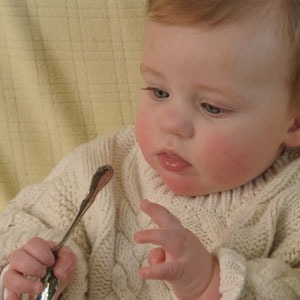Transitioning Your Child To Eating On His Or Her Own
It's a stage that many parents remember well — transitioning their son or daughter off the bottle and onto solid foods. The rejected spoonfuls of puréed carrots and apples that would dribble down chins. Bits of cereal that would make it to the mouth, but then somehow off the highchair table. And, of course, the oatmeal for breakfast that always seemed to end up in the hair, down the shirt, and all over — just never in the mouth.
Now that you've got them eating solid foods, it's time to get them to start feeding themselves. But where to begin? We went straight to Catherine McCord, a mom of two young kids (who both now feed themselves), and author of the kid-friendly blog, Weelicious, for advice.
When to Start
According to McCord, every child is different. "My son took a while to get a hang of it and my daughter was the baby that wanted to feed herself from day one." It comes down to how curious — then comfortable — the child is with the spoon.
wood, bamboo, or even silver). "Start feedings by offering your baby a spoon and showing them yours," advises McCord. It will empower them and give them the independence some want. And if they're not interested in it, that's fine — they're just not ready yet. If they'd rather hold onto the spoon and play with it like a toy, that's OK, too. In the end, "practice makes perfect," McCord says, "it's a big part of the learning curve." (Photo courtesy of Oneida.com)
Introducing the Fork (and Knife)
Don't introduce the fork until your child is eating small pieces of small food like melon, cut up chicken or hot dogs, or even macaroni. Show them how it's used by example and then have them do the same. McCord adds, "chasing food around on their plates and learning how to fork it is a ton of fun for kids."
McCord recommends waiting until your child is around four before introducing the knife. It will take some time for your child to learn how to hold it and how much force is necessary to cut through chicken versus pancakes. And even then, most kids will still ask for mom and dad's help, adds McCord, "and it's probably for the best."
Tips for Success
When teaching your child how to feed themselves, the key to success is by leading by example. Children will often mimic the actions of those other people around them, watching how people hold the spoon and bring it to the mouth. They will also pick up on your habits, too, so be sure to use good eating habits yourself and don't expect your child to feed themselves and demonstrate good table manners all at once — it takes time (and practice).
Make Mealtime Fun
As with anyone learning something new, children learning how to eat need to have a little fun, too, often by smearing puréed vegetables all over their face and hair. Don't worry — this isn't a setback. "Most babies go through a food smooshing phase; that's just part of the fun of learning about the taste and texture of food," says McCord. And as with the rest of us, kids learn by using their senses, so hands and mouths play a big role in understanding the world around them.
Family-Favorite Mealtime Games
In McCord's home, a game of happy and sad is a favorite way to make mealtimes fun. "We all go around the table and say one thing that made us happy that day and one thing that made us sad. It's a great way for everyone to get involved from the youngest to the oldest."
Other family mealtime favorites include talking about colors that are on the plates or at the table. "I'll ask something like I have green peas on my plate. What else do you like that's green?" Getting kids involved at mealtime with games like these really helps with establishing good eating habits, encouraging curiosity when it comes to new foods, and of course staying focused on family time.

